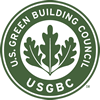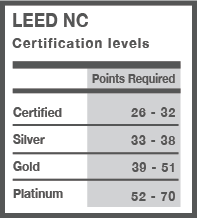 Leadership in Energy and Environmental Design (LEED®) is a rating system developed by
US Green Building Council (USGBC)
to provide a definitive standard for what constitutes
a green building in design, construction and operation. Leadership in Energy and Environmental Design (LEED®) is a rating system developed by
US Green Building Council (USGBC)
to provide a definitive standard for what constitutes
a green building in design, construction and operation.
 In Canada, the LEED® rating system is administered through an exclusive license agreement with
the Canadian Green Building Council (CaGBC).
The rating system in both countries is implemented using traditional design guidelines and
a tool called the LEED® scorecard. LEED Canada - NC 1.1 (New Construction) consists
of an explicit set of environmental criteria, organized into five performance categories: SS, WE, EA, MR, and EQ.
A sixth catgeory (ID) rewards exemplary performance or innovation beyond the criteria in the previous categories.
Each category consists of a collection of prerequisites and credits which are earned
In Canada, the LEED® rating system is administered through an exclusive license agreement with
the Canadian Green Building Council (CaGBC).
The rating system in both countries is implemented using traditional design guidelines and
a tool called the LEED® scorecard. LEED Canada - NC 1.1 (New Construction) consists
of an explicit set of environmental criteria, organized into five performance categories: SS, WE, EA, MR, and EQ.
A sixth catgeory (ID) rewards exemplary performance or innovation beyond the criteria in the previous categories.
Each category consists of a collection of prerequisites and credits which are earned
 depending on the "greeness" of the project's design and construction.
At the end of construction, the prerequisites and credits are documented and
submitted to the Green Building Certification Institute (GBCI)
for evaluation and final certification. For LEED®-NC 1.1 projects in Canada,
four certification levels are possible depending on the points earned.
The Reliable Controls Headquarters building has been designed and constructed to meet LEED® Platinum, the highest level achievable.
To understand how the Reliable Controls System aids in earning LEED points,
Click here.
depending on the "greeness" of the project's design and construction.
At the end of construction, the prerequisites and credits are documented and
submitted to the Green Building Certification Institute (GBCI)
for evaluation and final certification. For LEED®-NC 1.1 projects in Canada,
four certification levels are possible depending on the points earned.
The Reliable Controls Headquarters building has been designed and constructed to meet LEED® Platinum, the highest level achievable.
To understand how the Reliable Controls System aids in earning LEED points,
Click here.
Click on each of the six categories below to read the LEED® Description for each prerequisite and credit, and understand
the details of the Reliable Controls Implementation that was completed in order to earn the LEED® Platinum Certification.
|
| LEED® Category |
Points / Possible |
|
|
-
|
|
This LEED category evaluates the project with respect to construction
pollution prevention, soil erosion, suitability of land-use, connectivity
to community, parking, preservation of habitat and biodiversity, reduced
stormwater use, and reduced heat island effect and light pollution
|
| |
-
|
|
This LEED category evaluates the project with respect to reducing the burden on municipal water supply and wastewater systems, and limiting or eliminating the use of potable water for landscape irrigation
|
| |
-
|
|
This LEED category verifies that the project's energy related systems are installed and calibrated to perform properly, and the environmental and economic impacts of energy use are minimized
|
| |
-
|
|
This LEED category evaluates the project during the construction and operation of the building with respect to reduction of waste, the reuse of existing materials, the use of renewable and recycled materials, as well as the collection of recyclable materials
|
| |
-
|
|
This LEED category evaluates the project with respect to the quality of the indoor environment and its impact on the comfort and well-being of its occupants. The controllability of indoor air quality, thermal comfort and lighting form a key part of this category
|
| |
-
|
|
This category evaluates the project with respect to innovative strategies implemented but not addressed by LEED, and exemplary performance achieved that are above the requirements set by LEED.
|
| |
|
| Total LEED™ Points 56 / 70 |
|
|
|
|
|


